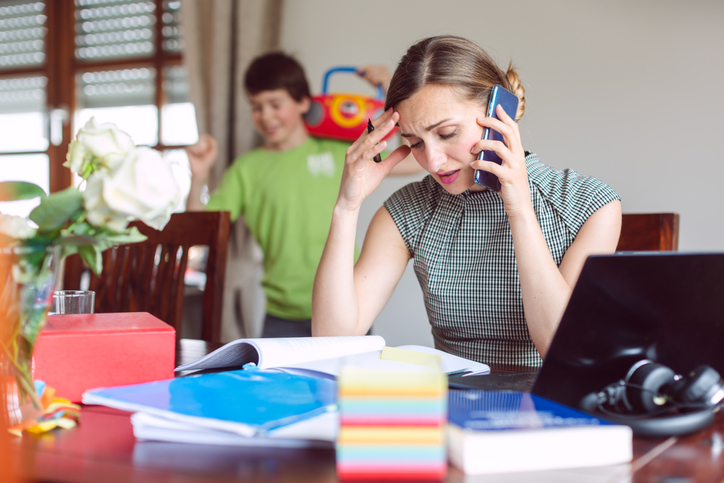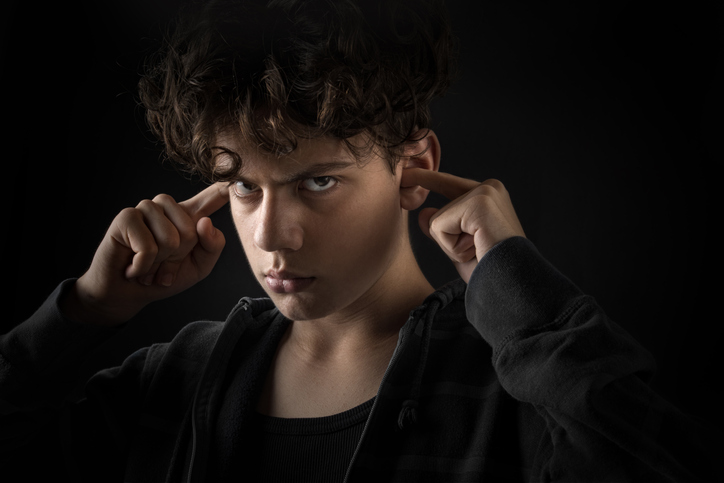 Now, more than ever, there seems to be very little we can predict and hold onto. Everyday, we hear new reports about climbing COVID cases as we struggle to practice safety measures, keep up with work, manage bored kids and keep our sanity intact. It can all feel too much to handle. Of course, in the midst of trying to keep your head above the water, there’s nothing like a defiant ADHD teen or tween to put you over the edge. How do you cope with the overwhelming stress? What can you do to help your child manage their big feelings and reduce family conflict?
Now, more than ever, there seems to be very little we can predict and hold onto. Everyday, we hear new reports about climbing COVID cases as we struggle to practice safety measures, keep up with work, manage bored kids and keep our sanity intact. It can all feel too much to handle. Of course, in the midst of trying to keep your head above the water, there’s nothing like a defiant ADHD teen or tween to put you over the edge. How do you cope with the overwhelming stress? What can you do to help your child manage their big feelings and reduce family conflict?
Why teens and tweens with ADHD are engaging in more defiant behavior
Angry and frustrated with the many changes to their lives wrought by COVID, and feeling helpless to do anything, many kids are acting out in ways that are often inappropriate. It seems that they’ve taken a giant step backwards in managing their distress. With their executive functioning challenges related to emotional and impulse control, scattered kids are prone to intense pushback and aggressive anger.  Teens and tweens with ADHD, whose brains mature more slowly than their neurotypical peers, are particularly torn between what they would like to be capable of doing and what they can actually accomplish. They’re often very frustrated with themselves, and, unable to tolerate their shame, act out their personal dissatisfaction towards others–often their parents. They unconsciously want you to make it better for them, just like a young child would. Teens are still struggling with how to tolerate disappointment appropriately and how to pivot when faced with limits they don’t like. With all of the changes surrounding COVID and losses of familiar and beloved activities, the natural challenges with shifting, flexibility and planning for transitions for many kids with ADHD are intensified. Of course, when they are triggered, emotional and verbal impulse control fly out of the window.
Teens and tweens with ADHD, whose brains mature more slowly than their neurotypical peers, are particularly torn between what they would like to be capable of doing and what they can actually accomplish. They’re often very frustrated with themselves, and, unable to tolerate their shame, act out their personal dissatisfaction towards others–often their parents. They unconsciously want you to make it better for them, just like a young child would. Teens are still struggling with how to tolerate disappointment appropriately and how to pivot when faced with limits they don’t like. With all of the changes surrounding COVID and losses of familiar and beloved activities, the natural challenges with shifting, flexibility and planning for transitions for many kids with ADHD are intensified. Of course, when they are triggered, emotional and verbal impulse control fly out of the window.
 Underneath all of their bluster, many defiant ADHD teens and tweens suffer from low self-esteem and shame. They need tools for expressing themselves appropriately and signs of parental support for their attempts to use these techniques, even if they’re not completely successful. You’ve got to remember that, while they may seem to enjoy the sense of power in the moment, they really don’t like the conflict any more than you do. It’s just that they lack certain skills which could help them.
Underneath all of their bluster, many defiant ADHD teens and tweens suffer from low self-esteem and shame. They need tools for expressing themselves appropriately and signs of parental support for their attempts to use these techniques, even if they’re not completely successful. You’ve got to remember that, while they may seem to enjoy the sense of power in the moment, they really don’t like the conflict any more than you do. It’s just that they lack certain skills which could help them.
Steps to disrupting cycles of defiance for ADHD teens and tweens:
1. Acknowledge their frustration:
Instead of convincing your defiant ADHD teen or tween why things aren’t the way that they perceive them, validate their feelings. Mirror what you hear them saying with language like, “I hear that you are upset about X” or, “What you’re telling me is Y.” When kids feel seen and heard, they’ll begin to slow down.
2. Set ground rules about acceptable behavior:
Discuss with your kids what ways of expressing anger or displeasure is appropriate and what are not. Be specific about language and physical actions. In addition, set up incentives for cooperating and logical consequences for obstruction. For instance, “If you curse at me, you will not earn the privilege of your phone for the rest of the day.” Or, “If you can go through a day and not scream or break something, you’ll earn extra screen time.” Work with incentives that matter to them.
3. Plan for arguments:
Let’s face it, you will get into fights. Instead of being surprised each time this happens, identify signs that you are heading into the red zone and how to take a planned, timed break. Make a list of acceptable choices for this “Calm-me-down” time and post it in the kitchen and bedrooms. Separate for an agreed-upon time until you can re-convene without hot tempers from defiant ADHD teens or tweens. For some kids, this break may need to be a few hours. That’s okay.
4. Decide what’s next:
 Instead of trying to teach a lesson, talk about what’s needed to move on. Ask questions, listen and reflect back what you hear. Wonder about alternative choices you both could have made in that instant or could make in the future. Collaborate on an action for moving on. Refer back to your agreement about ground rules while staying compassionate but firm. You can talk about any lessons at another time, perhaps the next day in the car or perhaps at a scheduled hour. It’s really important to notice and validate the activities and emotions that your defiant teen is becoming triggered. This type of validation will lower their rage and shame. Your goal is to cool the flames in the moment and follow your collaborative agreement. Teaching lessons will come later.
Instead of trying to teach a lesson, talk about what’s needed to move on. Ask questions, listen and reflect back what you hear. Wonder about alternative choices you both could have made in that instant or could make in the future. Collaborate on an action for moving on. Refer back to your agreement about ground rules while staying compassionate but firm. You can talk about any lessons at another time, perhaps the next day in the car or perhaps at a scheduled hour. It’s really important to notice and validate the activities and emotions that your defiant teen is becoming triggered. This type of validation will lower their rage and shame. Your goal is to cool the flames in the moment and follow your collaborative agreement. Teaching lessons will come later.
Learn more:
 During this pandemic, we all are experiencing heightened anxiety and there is so much we can’t control. What we eat is luckily something we can control now. Some foods are good for our physical, emotional well-being, and some are not.
During this pandemic, we all are experiencing heightened anxiety and there is so much we can’t control. What we eat is luckily something we can control now. Some foods are good for our physical, emotional well-being, and some are not. During this pandemic, we all are experiencing heightened anxiety and there is so much we can’t control. What we eat is luckily something we can control now. Some foods are good for our physical, emotional well-being, and some are not.
During this pandemic, we all are experiencing heightened anxiety and there is so much we can’t control. What we eat is luckily something we can control now. Some foods are good for our physical, emotional well-being, and some are not.

 your kids are going back to school in person or a hybrid learning situation, there are complicated issues facing families everywhere. Anxiety wants security and certainty and, with COVID related risks, we just don’t have much of that these days. To help you manage your anxiety, try these tools:
your kids are going back to school in person or a hybrid learning situation, there are complicated issues facing families everywhere. Anxiety wants security and certainty and, with COVID related risks, we just don’t have much of that these days. To help you manage your anxiety, try these tools: you and your family. If not, explore what choices make you feel most comfortable. Give your student the tools they’ll need. Provide your child or teen with masks and hand sanitizer. Show them what physical distancing looks like: use a tape measure to demonstrate six feet. Review hand-washing techniques and the importance of not sharing food or drinks. Set up a routing of hand sanitization when they come home from school.
you and your family. If not, explore what choices make you feel most comfortable. Give your student the tools they’ll need. Provide your child or teen with masks and hand sanitizer. Show them what physical distancing looks like: use a tape measure to demonstrate six feet. Review hand-washing techniques and the importance of not sharing food or drinks. Set up a routing of hand sanitization when they come home from school.  thirty minutes of meditation or yoga, a walk, run or bike ride outside or dancing to your favorite song each morning, find something that makes you feel good and do it. We need those wonderful endorphins from exercise now more than ever. The benefits from daily yoga and/or meditation will help you practice how to monitor your reactivity and use your breath or slow movements to calm yourself down during those inevitable stressful moments. Make a list of quick calm-me-down activities when you feel nervous that includes changing your environment (go to a different room or get a breath of fresh air), drinking a glass of water, saying a positive affirmation that you believe or going to the bathroom and splashing water on your face.
thirty minutes of meditation or yoga, a walk, run or bike ride outside or dancing to your favorite song each morning, find something that makes you feel good and do it. We need those wonderful endorphins from exercise now more than ever. The benefits from daily yoga and/or meditation will help you practice how to monitor your reactivity and use your breath or slow movements to calm yourself down during those inevitable stressful moments. Make a list of quick calm-me-down activities when you feel nervous that includes changing your environment (go to a different room or get a breath of fresh air), drinking a glass of water, saying a positive affirmation that you believe or going to the bathroom and splashing water on your face.
 Teens experience a few types of academic burnout depending on their individual situations. For neurotypical kids, academic burnout usually arises towards the end of the semester when they are burdened with final tests, projects and paper in addition to their other commitments such as sports, music or theater or work. For high-achieving kids who are taking AP classes, preparing for AP tests can add to their stress. For juniors in high school who additionally have to take the SAT’s or ACT’s for college, it can be overwhelming. They can become exhausted with how much they have to do.
Teens experience a few types of academic burnout depending on their individual situations. For neurotypical kids, academic burnout usually arises towards the end of the semester when they are burdened with final tests, projects and paper in addition to their other commitments such as sports, music or theater or work. For high-achieving kids who are taking AP classes, preparing for AP tests can add to their stress. For juniors in high school who additionally have to take the SAT’s or ACT’s for college, it can be overwhelming. They can become exhausted with how much they have to do. Now, more than ever, there seems to be very little we can predict and hold onto. Everyday, we hear new reports about climbing COVID cases as we struggle to practice safety measures, keep up with work, manage bored kids and keep our sanity intact. It can all feel too much to handle.
Now, more than ever, there seems to be very little we can predict and hold onto. Everyday, we hear new reports about climbing COVID cases as we struggle to practice safety measures, keep up with work, manage bored kids and keep our sanity intact. It can all feel too much to handle. 
 Underneath all of their bluster, many defiant ADHD teens and tweens suffer from low self-esteem and shame. They need tools for expressing themselves appropriately and signs of parental support for their attempts to use these techniques, even if they’re not completely successful. You’ve got to remember that, while they may seem to enjoy the sense of power in the moment, they really don’t like the conflict any more than you do. It’s just that they lack certain skills which could help them.
Underneath all of their bluster, many defiant ADHD teens and tweens suffer from low self-esteem and shame. They need tools for expressing themselves appropriately and signs of parental support for their attempts to use these techniques, even if they’re not completely successful. You’ve got to remember that, while they may seem to enjoy the sense of power in the moment, they really don’t like the conflict any more than you do. It’s just that they lack certain skills which could help them. Instead of trying to teach a lesson, talk about what’s needed to move on. Ask questions, listen and reflect back what you hear. Wonder about alternative choices you both could have made in that instant or could make in the future. Collaborate on an action for moving on. Refer back to your agreement about ground rules while staying compassionate but firm. You can talk about any lessons at another time, perhaps the next day in the car or perhaps at a scheduled hour.
Instead of trying to teach a lesson, talk about what’s needed to move on. Ask questions, listen and reflect back what you hear. Wonder about alternative choices you both could have made in that instant or could make in the future. Collaborate on an action for moving on. Refer back to your agreement about ground rules while staying compassionate but firm. You can talk about any lessons at another time, perhaps the next day in the car or perhaps at a scheduled hour. 




 After a spring semester with remote learning and its many complications for students, parents and educators, schools
After a spring semester with remote learning and its many complications for students, parents and educators, schools 
 Although many things about school remain in flux, now is a good time to begin preparing your kids and yourself emotionally and mentally for the re-entry. Start with these steps:
Although many things about school remain in flux, now is a good time to begin preparing your kids and yourself emotionally and mentally for the re-entry. Start with these steps:
